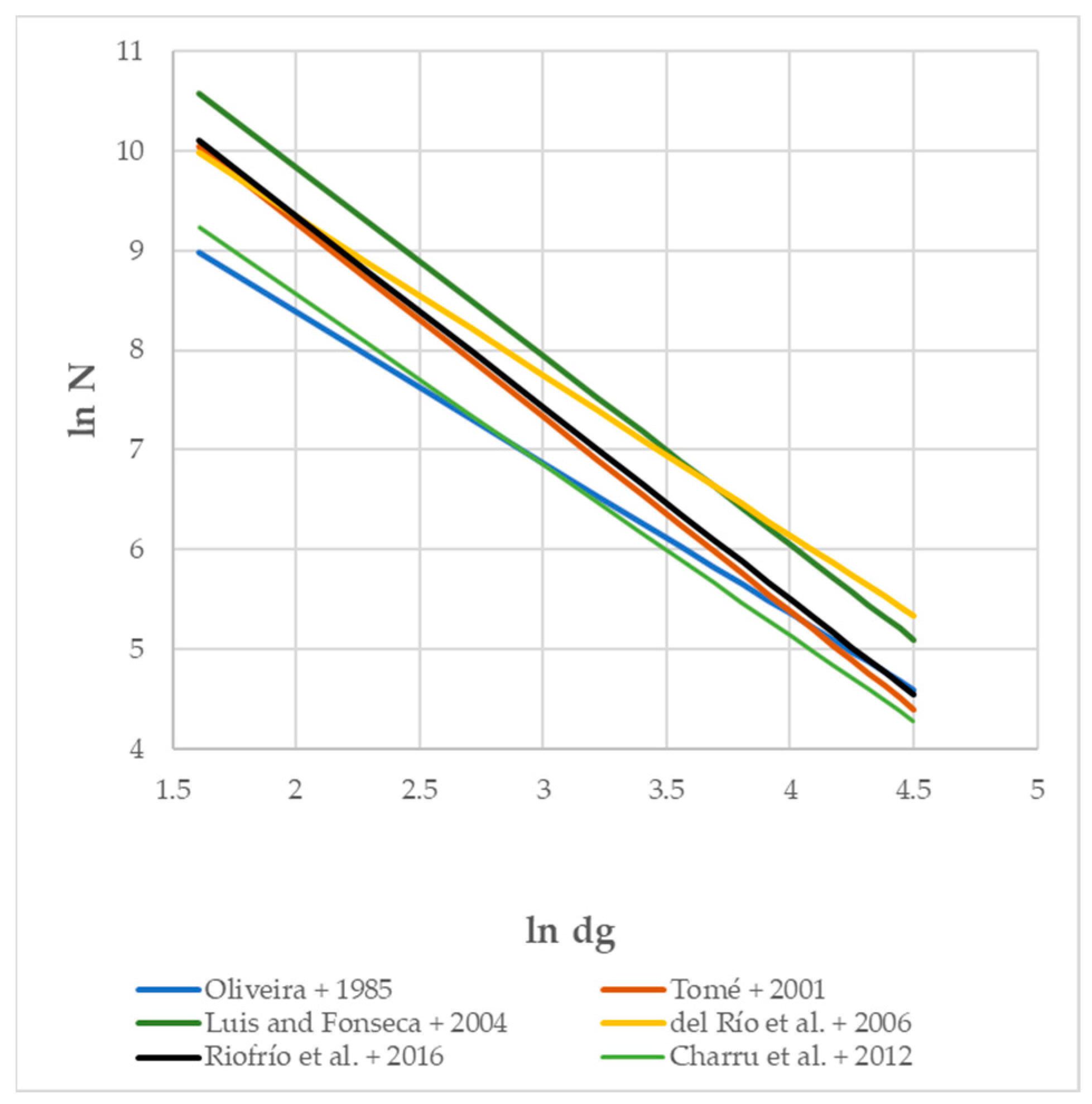The Importance of Using Permanent Plots Data to Fit the Self-Thinning Line: An Example for Maritime Pine Stands in Portugal
Abstract
1. Introduction
The Self-Thinning Line for Maritime Pine
2. Materials and Methods
2.1. Data
- For an overall pre-analysis, the data from the whole dataset were initially plotted together. Three of the self-thinning lines found in the literature, selected as representing well the spread among the different lines, were also plotted just for comparison: Luís and Fonseca [22]; Tomé [29] and Charru et al. [32].
- Then, the data for each trial were plotted jointly with the three self-thinning lines selected and, by examining the graphs, the trials with no evidence of self-thinning were discarded.
- In the remaining trials, all the non-thinned plots (e.g., control plots from the thinning trials) were selected.
- For each selected plot, graphs of ln N versus ln dg were created to assess whether the trajectories approached an MSDR dynamic thinning line boundary. A comparison with the three self-thinning lines referred in 1. helped deciding.
- Following the methodology used by VanderSchaaf and Burkhart [28] all the selected plots were visually assessed and only those points occurring along an MSDR dynamic thinning line boundary were selected, often eliminating the initial measurements of the plots. A plot was included in the analysis if there were at least two consecutive points along an MSDR dynamic thinning line.
- During this procedure, some of the trials or measurements previously selected in 4. were discarded. The final data set, containing just plots in a self-thinning stage, was used to fit the self-thinning line.
2.2. Estimating the MSDR Species Boundary Line Coefficients
- bi~N (0, D)
- εi~N (0, ∑i)
- b1, …, bn, ε1, …, εn are independent.
3. Results
4. Discussion
5. Conclusions
Supplementary Materials
Author Contributions
Funding
Data Availability Statement
Acknowledgments
Conflicts of Interest
References
- ICNF. 6.o Inventário Florestal Nacional (IFN6)—2015 Relatório Final; ICNF: Lisboa, Portugal, 2019.
- INE. Estatísticas Agrícolas—2021; INE: Lisboa, Portugal, 2022.
- INE. Estatísticas de Comércio Internacional—2019. Available online: https://www.ine.pt/xportal/xmain?xpid=INE&xpgid=ine_publicacoes&PUBLICACOESpub_boui=133545&PUBLICACOESmodo=2 (accessed on 27 December 2022).
- Vanclay, J.K. Modelling Forest Growth and Yield: Applications to Mixed Tropical Forests, 1st ed.; CAB International: Wallingford, UK, 1994; ISBN 0851989136.
- Burkhart, H.E.; Tomé, M. Quantifying Stand Density. In Modeling Forest Trees and Stands; Springer: Dordrecht, The Netherlands, 2012; pp. 175–200. [Google Scholar]
- Tapias, R.; Climent, J.; Pardos, J.A.; Gil, L. Life histories of Mediterranean pines. In The Plant Ecology; Springer: Berlin/Heidelberg, Germany, 2004; Volume 171, pp. 53–68. [Google Scholar]
- Maia, P.; Keizer, J.; Vasques, A.; Abrantes, N.; Roxo, L.; Fernandes, P.; Ferreira, A.; Moreira, F. Post-fire plant diversity and abundance in pine and eucalypt stands in Portugal: Effects of biogeography, topography, forest type and post-fire management. For. Ecol. Manag. 2014, 334, 154–162. [Google Scholar] [CrossRef]
- Enes, T.; Lousada, J.; Aranha, J.; Cerveira, A.; Alegria, C.; Fonseca, T. Size–density trajectory in regenerated maritime pine stands after fire. Forests 2019, 10, 1057. [Google Scholar] [CrossRef]
- Brunet-Navarro, P.; Sterck, F.J.; Vayreda, J.; Martinez-Vilalta, J.; Mohren, G.M.J. Self-thinning in four pine species: An evaluation of potential climate impacts. Ann. For. Sci. 2016, 73, 1025–1034. [Google Scholar] [CrossRef]
- White, J.; Harper, J.L. Correlated Changes in Plant Size and Number in Plant Populations. J. Ecol. 1970, 58, 467. [Google Scholar] [CrossRef]
- Smith, N.J.; Hann, D.W. A growth model based on the self-thinning rule. Can. J. For. Res. 1986, 16, 330–334. [Google Scholar] [CrossRef]
- Yoda, K.; Kira, T.; Ogawa, H.; Hozumi, K. Self-thinning in overcrowded pure stands under cultivated and natural conditions. J. Biol. 1963, 14, 107–129. [Google Scholar]
- Zeide, B. Analysis of the 3/2 Power Law of Self-Thinning; Oxford Academic: Oxford, UK, 1987; Volume 33. [Google Scholar]
- Reineke, L.H. Perfecting a stand-density index for even-aged forests. J. Agric. Res. 1933, 46, 627–638. [Google Scholar]
- von Gadow, K. Observations on self-thinning in pine plantations. S. Afr. J. Sci. 1986, 82, 364–368. [Google Scholar]
- White, J. The allometric interpretation of the self-thinning rule. J. Theor. Biol. 1981, 89, 475–500. [Google Scholar] [CrossRef]
- McCarter, J.B.; Long, J.N. A Lodgepole Pine Density Management Diagram. West. J. Appl. For. 1986, 1, 6–11. [Google Scholar] [CrossRef]
- Dean, T.J.; Jokela, E.J. A Density-Management Diagram for Slash Pine Plantations in the Lower Coastal Plain. South. J. Appl. For. 1992, 16, 178–185. [Google Scholar] [CrossRef]
- Oliveira, A.C. Tabela de Produção Geral Para o Pinheiro Bravo das Regiões Montanas e Sub-Montanas; Direção Geral das Florestas/Centro de Estudos Florestais (INIC): Lisboa, Portugal, 1985. [Google Scholar]
- Dean, T.; Baldwin, V.C.J. Using a Density-Management Diagram to Develop Thinning Schedules for Loblolly Pine Plantations. Res. Pap. SO-275 1993, 275, 12. [Google Scholar]
- Cao, Q.V.; Dean, T.J.; Baldwin, V.C. Modeling the size-density relationship in direct-seeded slash pine stands. For. Sci. 2000, 46, 317–321. [Google Scholar]
- Luis, J.F.S.; Fonseca, T.F. The allometric model in the stand density management of Pinus pinaster Ait. in Portugal. Ann. For. Sci. 2004, 61, 807–814. [Google Scholar] [CrossRef]
- Harper, J.L. Population Biology of Plants; Academic Press: Cambridge, NY, USA, 1977; ISBN 0123258502. [Google Scholar]
- Aguirre, A.; del Río, M.; Condés, S. Intra- and inter-specific variation of the maximum size-density relationship along an aridity gradient in Iberian pinewoods. For. Ecol. Manag. 2018, 411, 90–100. [Google Scholar] [CrossRef]
- Andrews, C.; Weiskittel, A.; D’Amato, A.W.; Simons-Legaard, E. Variation in the maximum stand density index and its linkage to climate in mixed species forests of the North American Acadian Region. For. Ecol. Manag. 2018, 417, 90–102. [Google Scholar] [CrossRef]
- Zeide, B. A relationship between size of trees and their number. For. Ecol. Manag. 1995, 72, 265–272. [Google Scholar] [CrossRef]
- Fonseca, T.; Monteiro, L.; Enes, T.; Cerveira, A. Self-thinning dynamics in cork oak woodlands: Providing a baseline for managing density. For. Syst. 2017, 26, e006. [Google Scholar] [CrossRef]
- VanderSchaaf, C.L.; Burkhart, H.E. Comparison of methods to estimate Reineke’s maximum size-density relationship species boundary line slope. For. Sci. 2007, 53, 435–442. [Google Scholar]
- Tomé, M. Tabela de Produção Geral Para o Pinheiro Bravo em Portugal; Universidade Técnica de Lisboa: Lisboa, Portugal, 2001. [Google Scholar]
- del Río, M.; Lopez-Senespleda, E.; Montero, G. Manual de Gestión Para Masas Procedentes de Repoblación de Pinus pinaster Ait, Pinus sylvestris L. y Pinus nigra Arn. en Castilla y León; Consejería de Medio Ambiente, Junta de Castilla y León: León, Spain, 2006. [Google Scholar]
- Riofrío, J.; del Río, M.; Bravo, F. Mixing effects on growth efficiency in mixed pine forests. Forestry 2016, 90, 381–392. [Google Scholar] [CrossRef]
- Charru, M.; Seynave, I.; Morneau, F.; Rivoire, M.; Bontemps, J.D. Significant differences and curvilinearity in the self-thinning relationships of 11 temperate tree species assessed from forest inventory data. Ann. For. Sci. 2012, 69, 195–205. [Google Scholar] [CrossRef]
- Palma, J. CliPick—Climate change web picker. A tool bridging daily climate needs in process based modelling in forestry and agriculture. For. Syst. 2017, 26, 2171–9845. [Google Scholar]
- SNIAmb Visualizador SNIAmb—Atlas—Atlas do Ambiente. Available online: https://sniamb.apambiente.pt/content/geo-visualizador?language=pt-pt (accessed on 3 April 2023).
- Araujo, K.D.; De Andrade, A.P.; Cavalcanti, R.W. GEOAMBIENTE ON-LINE. 2008. Available online: https://revistas.ufg.br/geoambiente/issue/view/1373 (accessed on 3 April 2023).
- Martonne, E. Une Nouvelle Fonction CIimatologique: L’Indice d’Aridite (A New CIimatological Function: The Aridity Index). La Météorologie 1926, 2, 449–458. [Google Scholar]
- Condés, S.; Vallet, P.; Bielak, K.; Bravo-Oviedo, A.; Coll, L.; Ducey, M.J.; Pach, M.; Pretzsch, H.; Sterba, H.; Vayreda, J.; et al. Climate influences on the maximum size-density relationship in Scots pine (Pinus sylvestris L.) and European beech (Fagus sylvatica L.) stands. For. Ecol. Manag. 2017, 385, 295–307. [Google Scholar] [CrossRef]
- Paulo, J.A.; Firmino, P.N.; Tomé, M. A tree- and climate-dependent growth model to predict mature annual cork thickness under different climate change scenarios. Model. Earth Syst. Environ. 2023, 2023, 1–14. [Google Scholar] [CrossRef]
- Hebbali, A. R Package “Olsrr”, Version 0.5.3; Tools for Building OLS Regression Models; 2022. Available online: https://olsrr.rsquaredacademy.com/ (accessed on 3 April 2023).
- Zuur, A.F.; Ieno, E.N.; Walker, N.J.; Saveliev, A.A.; Smith, G.M. Mixed Effects Models and Extensions in Ecology with R; Springer: Berlin/Heidelberg, Germany, 2009; ISBN 978-0-387-87457-9. [Google Scholar]
- R Core Team. R: A Language and Environment for Statistical Computing; R Found Statistical Computing: Vienna, Austria, 2022; p. 2. Available online: https://www.R-project.org (accessed on 27 December 2022).
- Bates, D.; Mächler, M.; Zurich, E.; Bolker, B.M.; Walker, S.C. Fitting Linear Mixed-Effects Models Using Lme4. J. Stat. Softw. 2015, 67, 1–48. [Google Scholar] [CrossRef]
- Pretzsch, H.; Biber, P. A re-evaluation of Reineke’s rule and stand density index. For. Sci. 2005, 51, 304–320. [Google Scholar]
- Bi, H. Stochastic frontier analysis of a classic self-thinning experiment. Austral Ecol. 2004, 29, 408–417. [Google Scholar] [CrossRef]
- Weiskittel, A.; Gould, P.; Temesgen, H. Sources of variation in the self-thinning boundary line for three species with varying levels of shade tolerance. For. Sci. 2009, 55, 84–93. [Google Scholar]
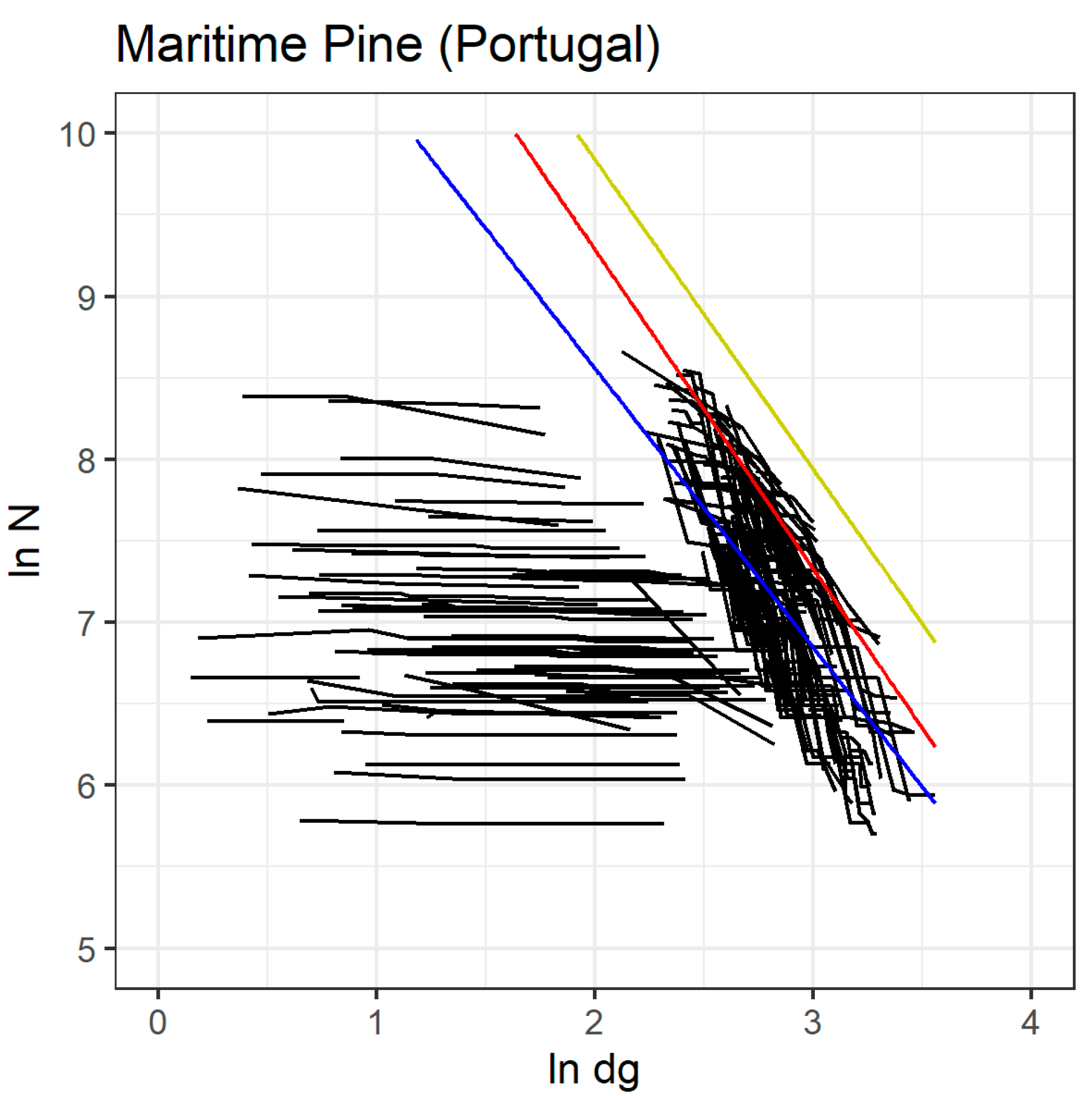
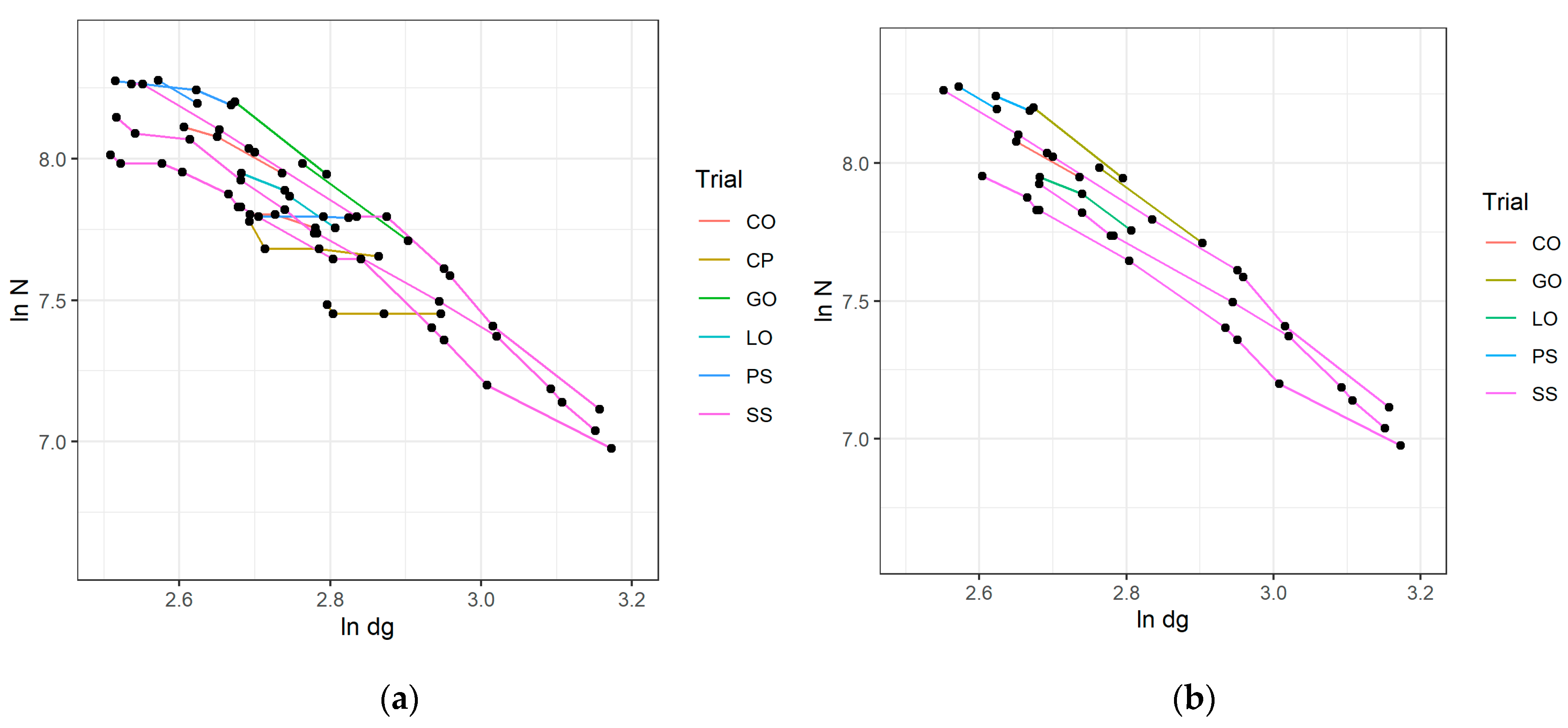
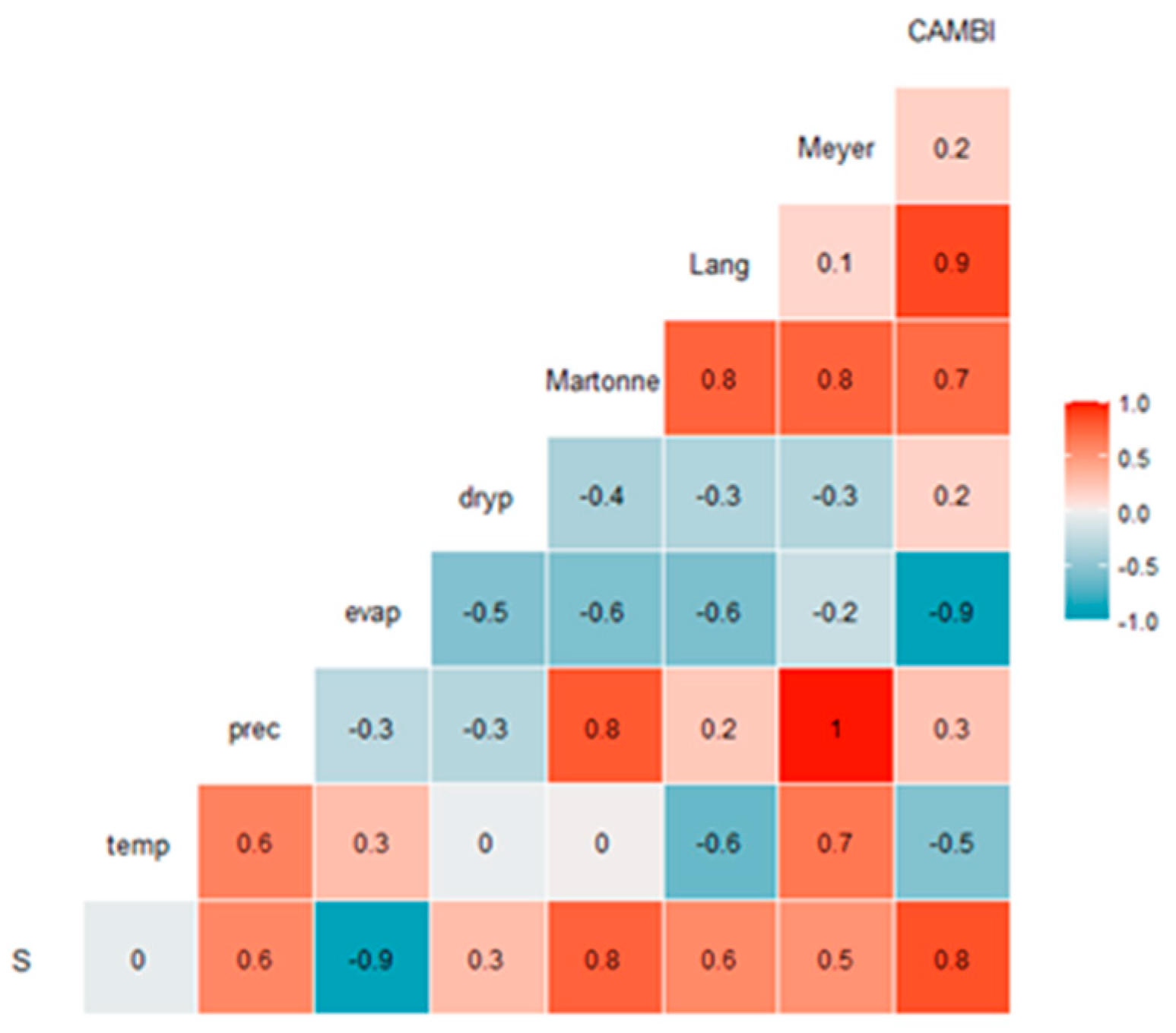
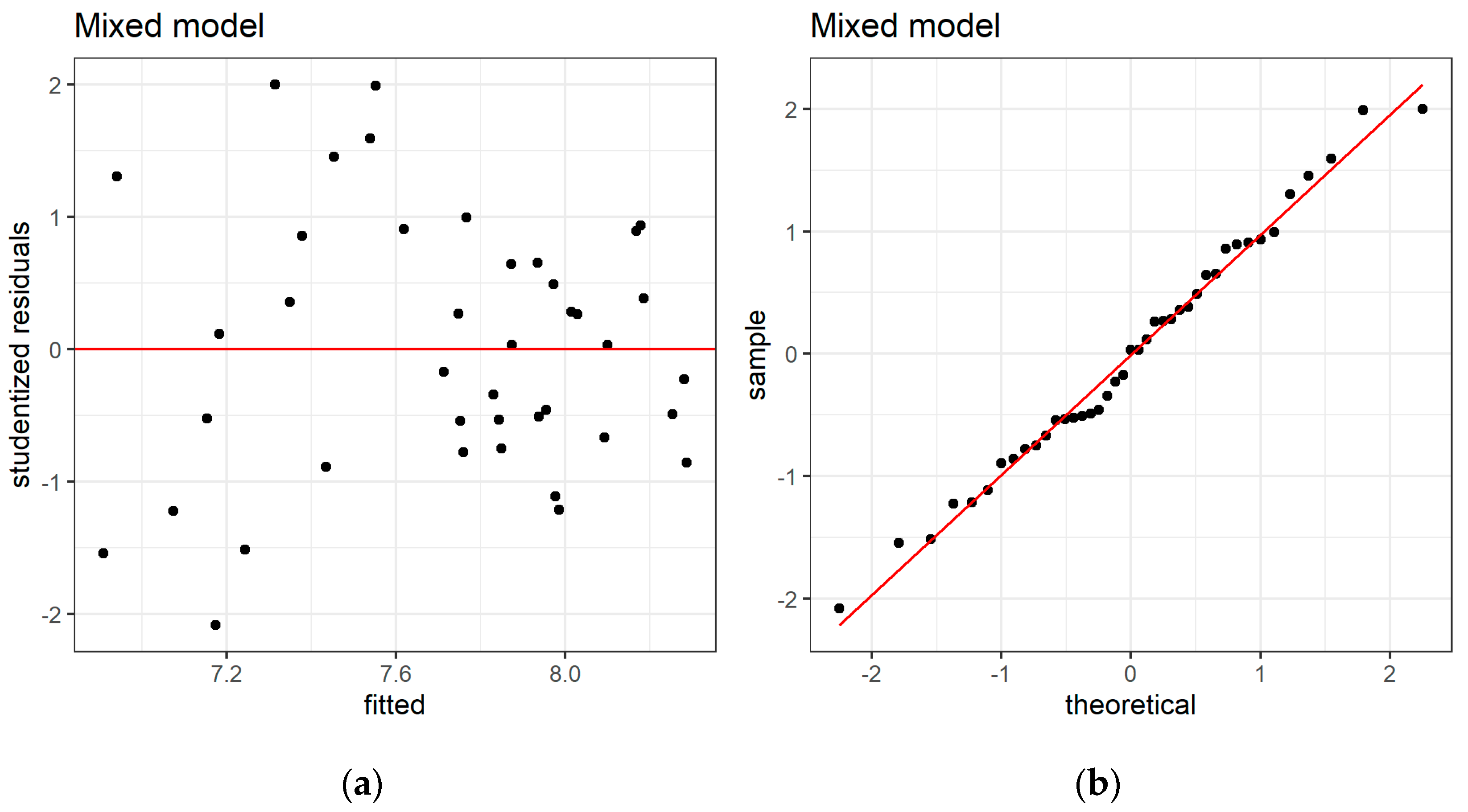
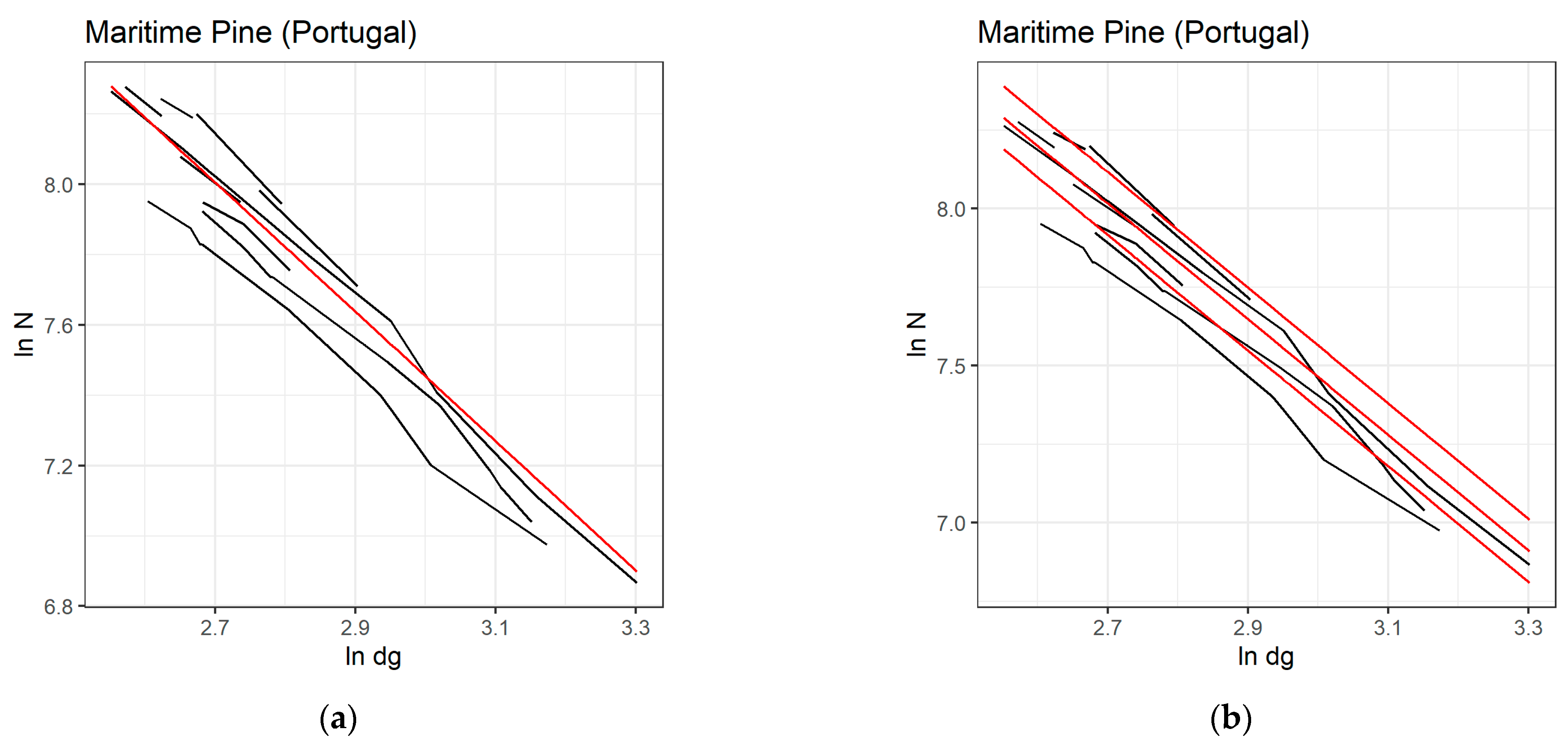
| Author(s) | Country | Region | Intercept | Slope | SDI 1 |
|---|---|---|---|---|---|
| Oliveira [19] | Portugal | Montanas e sub-montanas | 11.418 | −1.516 | 691 |
| Tomé [29] | Portugal | Whole country | 13.200 | −1.956 | 996 |
| Luís and Fonseca [22] | Portugal | Whole country | 13.634 | −1.897 | 1859 |
| del Río et al. [30] | Spain | Castilla y León | 12.562 | −1.605 | 1629 |
| Charru et al. [32] | France | Whole country, NFI data 2 | 11.982 | −1.711 | 648 |
| Riofrío et al. [31] | Spain | Whole country, NFI data 3 | 13.218 | −1.929 | 1106 |
| Whole Data Set (12 Trials, 186 Plots, n = 1338) | Self-Thinning Data Set (5 Trials, 9 Plots, n = 41) | |||||||
|---|---|---|---|---|---|---|---|---|
| Variables | Min | Mean | Max | Sd | Min | Mean | Max | Sd |
| t | 2.00 | 20.61 | 50.00 | 10.86 | 24.00 | 32.78 | 50.00 | 5.76 |
| hdom | 0.38 | 10.45 | 26.35 | 5.70 | 12.46 | 17.61 | 25.49 | 3.63 |
| dg | 0.00 | 12.39 | 35.24 | 7.68 | 12.83 | 17.19 | 27.16 | 3.49 |
| N | 300 | 1456 | 9796 | 1050 | 960 | 2419 | 3930 | 842 |
| G | 0.00 | 19.61 | 64.08 | 16.42 | 40.78 | 50.66 | 60.06 | 5.22 |
| S | 15.31 | 20.87 | 28.39 | 2.76 | 16.77 | 23.25 | 25.49 | 2.86 |
| temp | 8.7 | 12.3 | 14.9 | 1.76 | 8.7 | 10.8 | 11.8 | 1.27 |
| prec | 685.5 | 1096.4 | 1412.7 | 231.1 | 1093.7 | 1260.3 | 1363.1 | 125.7 |
| hum | 71.4 | 76.8 | 79.7 | 3.1 | 71.9 | 77.3 | 79.3 | 3.2 |
| evap | 1.0 | 1.3 | 2.4 | 0.4 | 1.0 | 1.3 | 1.5 | 0.2 |
| dryp | 2.7 | 3.4 | 4.2 | 0.5 | 2.7 | 2.7 | 3.6 | 0.4 |
| Martonne | 27.6 | 50.0 | 66.01 | 13.2 | 52.1 | 60.5 | 65.2 | 4.9 |
| Lang | 46.0 | 92.7 | 132.9 | 29.2 | 99.4 | 117.0 | 132.9 | 12.7 |
| Meyer | 7.7 | 12.1 | 15.5 | 2.5 | 11.9 | 13.8 | 14.9 | 1.5 |
| Covariate (X) | Parameter Estimates | Residual Variance | Adjusted R2 | AIC | |||
|---|---|---|---|---|---|---|---|
| Intercept | ln dg | X | X × ln dg | ||||
| none | 13.2282 | −1.9479 | - | - | 0.1066 | 0.924 | −63.24 |
| S | 13.3822 | −1.8377 | −0.0200 | - | 0.0933 | 0.942 | −73.31 |
| temp | 35.1886 | −10.1429 | −2.0324 | 0.7575 | 0.1000 | 0.933 | −66.69 |
| prec | 12.9643 | −1.5978- | - | −0.0193 | 0.1006 | 0.932 | −67.05 |
| evap | 12.6842 | −1.8662 | 0.2808 | - | 0.0944 | 0.940 | −72.29 |
| dryp | 13.1863 | −1.77068 | - | (.) −0.0549 | 0.1041 | 0.927 | −64.29 |
| Martonne | 13.0227 | −1.5781 | - | −0.0047 | 0.1013 | 0.931 | −66.52 |
| Lang | (ns) −9.0987 | (.) 6.3947 | 0.1780 | −0.0666 | 0.1018 | 0.930 | −65.18 |
| Meyer | 13.5972 | −1.8689 | −0.0409 | - | 0.1017 | 0.931 | −66.22 |
| cambi | 13.0888 | −1.8721 | - | −0.0337 | 0.1007 | 0.932 | −66.97 |
| Model ID | Variables in the Model | Max (VIF) | AIC | |
|---|---|---|---|---|
| Intercept | Slope | |||
| Ols.0 | - | ln dg | - | −63.24 |
| Ols.S | S | ln dg | 1.16 | −73.31 |
| Ols.evap | evap | ln dg | 1.09 | −72.29 |
| Ols.allpr.1 | dryp Meyer | ln dg prec | 3.14 | −77.39 |
| Ols.allpr.2 | Meyer | ln dg prec, ln dg dryp | 7.68 | −77.32 |
| Ols.allpr.3 | evap | ln dg dryp, ln dg Martonne | 1.74 | −77.27 |
| Ols.allpr.4 | - | ln dg evap, ln dg dryp, ln dg Martonne | 1.56 | −77.17 |
| Ols.allpr.5 | temp | ln dg temp, ln dg evap | 2.81 | −77.07 |
| Ols.allpr.6 | - | ln dg, ln dg temp, ln dg evap | 3.07 | −76.91 |
| Ols.allpr.7 | temp evap | ln dg temp | 3.30 | −76.88 |
| Ols.allpr.8 | - | ln dg evap, ln dg Lang, ln dg cambi | 66.33 | −76.88 |
| Ols.allpr.9 | temp | ln dg, ln dg evap | 1.24 | −76.87 |
| Ols.allpr.10 | evap | ln dg, ln dg temp | 3.31 | −76.82 |
| Model ID | Fixed Part | Random Part | AIC | Random Effects Variance | Residual Variance |
|---|---|---|---|---|---|
| Groups | |||||
| Mix1.all.poss | Ols.allpos.1 | (1|Trial) | −51.98 | 0.0046 | 0.0068 |
| Mix2.all.poss | Ols.allpos.1 | (1|Plot) | −108.12 | 0.0071 | 0.0009 |
| Mix3.all.poss | Ols.allpos.1 | (1|Trial/Plot) | −106.14 | 0.0065; 0.0010 | 0.0009 |
| Mix4.all.poss | Ols.allpos.1 | (1 + ln dg|Trial) | No conv | - | - |
| Mix5.all.poss | Ols.allpos.1 | (1 + ln dg|Trial/Plot) | No conv | - | - |
| Mix1.0 | Ols.0 | (1|Trial) | −65.39 | 0.0071 | 0.0068 |
| Mix2.0 | Ols.0 | (1|Plot) | −118.98 | 0.0113 | 0.0010 |
| Mix3.0 | Ols.0 | (1|Trial/Plot) | −118.66 | 0.0056; 0.0567 | 0.0010 |
| Mix4.0 | Ols.0 | (1 + ln dg|Trial) | −61.41 | 0.0263; 0.0008 | 0.0068 |
| Mix5.0 | Ols.0 | (1 + ln dg|Trial/Plot) | No conv | - | - |
| Mix1.S | Ols.S | (1|Trial) | −68.68 | 0.1352 | 0.0037 |
| Mix2.S | Ols.S | (1|Plot) | −113.90 | 0.0073 | 0.0010 |
| Mix3.S | Ols.S | (1|Trial/Plot) | −111.90 | 0.0073; 0.0000 | 0.0010 |
| Mix4.S | Ols.S | (1 + ln dg|Trial) | No conv | - | - |
| Mix5.S | Ols.S | (1 + ln dg|Trial/Plot) | No conv | - | - |
| Mix1.evap | Ols.evap | (1|Trial) | −62.90 | 0.0072 | 0.0068 |
| Mix2.evap | Ols.evap | (1|Plot) | −117.98 | 0.0088 | 0.0010 |
| Mix3.evap | Ols.evap | (1|Trial/Plot) | −116.44 | 0.0061; 0.0042 | 0.0010 |
| Mix4.evap | Ols.evap | (1 + ln dg|Trial) | −58.90 | 0.0220; 0.0006 | 0.0068 |
| Mix5.evap | Ols.evap | (1 + ln dg|Trial/Plot) | No conv | - | - |
| Application | Model |
|---|---|
| Species MSDR | ln N = 12.97158 − 1.83926 ln dg |
| Dynamic MSDR | ln N = 13.382229 − 1.837736 ln dg − 0.020023 S |
| ln N = 12.68419 − 1.86621 ln dg − 0.28084 evap | |
| ln N = 9.994402 − 0.255361 dryp + 0.235186 Meyer − 0.131783 ln dg prec + 0.001162 ln dg |
Disclaimer/Publisher’s Note: The statements, opinions and data contained in all publications are solely those of the individual author(s) and contributor(s) and not of MDPI and/or the editor(s). MDPI and/or the editor(s) disclaim responsibility for any injury to people or property resulting from any ideas, methods, instructions or products referred to in the content. |
© 2023 by the authors. Licensee MDPI, Basel, Switzerland. This article is an open access article distributed under the terms and conditions of the Creative Commons Attribution (CC BY) license (https://creativecommons.org/licenses/by/4.0/).
Share and Cite
Pavel, M.A.A.; Barreiro, S.; Tomé, M. The Importance of Using Permanent Plots Data to Fit the Self-Thinning Line: An Example for Maritime Pine Stands in Portugal. Forests 2023, 14, 1354. https://doi.org/10.3390/f14071354
Pavel MAA, Barreiro S, Tomé M. The Importance of Using Permanent Plots Data to Fit the Self-Thinning Line: An Example for Maritime Pine Stands in Portugal. Forests. 2023; 14(7):1354. https://doi.org/10.3390/f14071354
Chicago/Turabian StylePavel, Muha Abdullah Al, Susana Barreiro, and Margarida Tomé. 2023. "The Importance of Using Permanent Plots Data to Fit the Self-Thinning Line: An Example for Maritime Pine Stands in Portugal" Forests 14, no. 7: 1354. https://doi.org/10.3390/f14071354
APA StylePavel, M. A. A., Barreiro, S., & Tomé, M. (2023). The Importance of Using Permanent Plots Data to Fit the Self-Thinning Line: An Example for Maritime Pine Stands in Portugal. Forests, 14(7), 1354. https://doi.org/10.3390/f14071354






